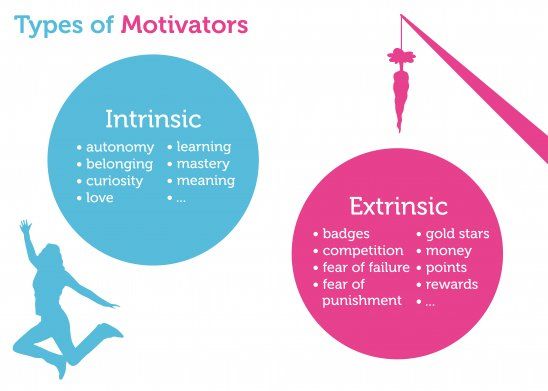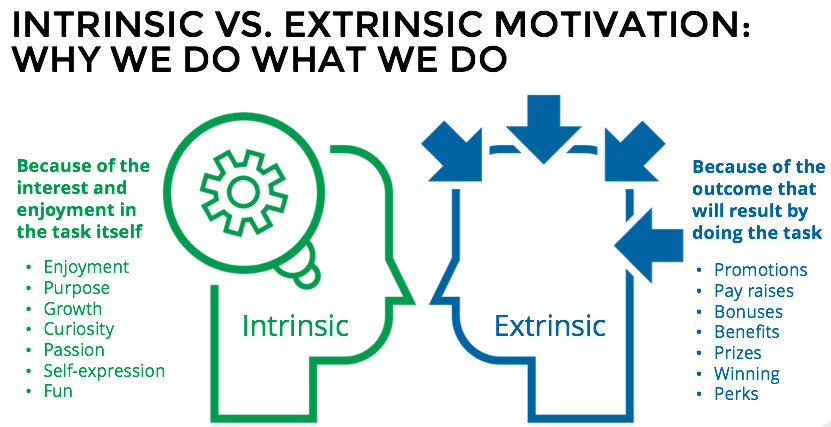Intrinsic vs. Extrinsic Motivation
Why do we do the things we do? What drives our behaviour? What motivates us? There are different ways of thinking about motivation, including looking at whether motivation arises from outside an individual (extrinsic) or inside an individual (intrinsic).
Researchers have found that each type of motivation has a different effect on a person’s behaviour and pursuit of goals. To better understand the influence of intrinsic and extrinsic motivation on human behaviour, it is helpful to learn how each type of motivation works. Keep in mind that both types of motivators are important and finding the balance between the two is key.

What is extrinsic motivation?
Extrinsic motivation is when someone is motivated to perform a behaviour or engage in an activity because he/she wants to earn a reward or avoid a punishment. An extrinsically motivated person will engage in behaviour not because he/she enjoys or finds it satisfying, but because he/she expects to get something in return (i.e., a reward) or to avoid something unpleasant (i.e., a punishment).
What is intrinsic motivation?
Intrinsic motivation, on the other hand, is when someone engages in a behaviour because he/she finds it personally rewarding. This person will perform an activity for its own sake, rather than being motivated by some external reward. The behaviour itself is its own reward. In other words, an intrinsically motivated person will engage in an activity because they find it personally enjoyable, satisfying, interesting, etc.

So, which is best?
Extrinsic motivation arises from outside of the individual while intrinsic motivation comes from within the individual. Research has shown that each type of motivation has a different effect on our behaviour. Intrinsic motivation is more personally rewarding and has longer lasting effects than extrinsic motivation. However, both types of motivation can be beneficial in different situations and as a teacher it’s important to understand the conditions under which each type is more effective — and to find the right balance between the two!
How can teachers develop students’ intrinsic motivation?
Extrinsic motivators are relatively easy to come up with (e.g., rewards, prizes, badges, etc.). What is harder for most teachers to develop is students’ intrinsic motivation. The word intrinsic means to come from inside, so it may seem counterintuitive to suggest that we can train a student to be intrinsically motivated. While we cannot change who a student is as an individual, we can can create learning environments that are better for developing intrinsic motivation. Here are a few ideas to build intrinsic motivation that I try to bring into the classroom as much as possible (Source):
1. Know your students
Get to know students as individuals and discover what they’re interested in and how they learn best. Then design lessons around these motivating factors.
2. Practice personalized goal-setting
Having students set personal learning goals improves both motivation and achievement, encourages a growth mindset, and also supports the development of skills students need to be prepared for their future careers.
3. Give specific (formative) feedback
Give students feedback that focuses on their strengths instead of their weaknesses and be as specific as you possibly can. Instead of saying “great job!” or “you’re so smart,” tie your comments directly to the student’s effort.
4. Tap into their innate curiosity
Encourage students to take on assignments simply because they want to know more, instead of feeling required to do so just to receive a grade.
5. As much as possible, allow students choice in their work
When students are given choices, they perceive classroom activities as more important. This increases their intrinsic motivation for putting in effort and going deeper with their learning.
6. Connect classroom activities and real-world situations
Ensuring students know that what they’re studying will help them meet their goals in the future will boost their intrinsic motivation.
7. Give students space
Independent practice is critical to learning, and offering too much help is often more problematic than not giving enough.
In summary, it is important to understand the difference between extrinsic and intrinsic motivation. Both are important in school settings. However, if the goal is to see a more long-term impact on motivation, it may be more important to focus on developing students’ sense of intrinsic motivation. In my teaching experience, I have found the above 7 ideas to be very helpful in developing intrinsically motivated students who engage in learning activities not just to get a reward or to avoid a punishment, but because they actually find it interesting and relevant to their lives and the real-world!

Sources
http://mmrg.pbworks.com/f/Ryan,+Deci+00.pdf
https://ww.weareteachers.com/understanding-intrinsic-vs-extrinsic-motivation-in-the-classroom/




